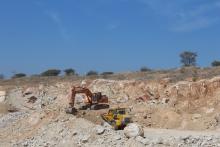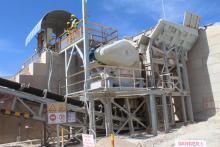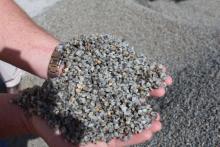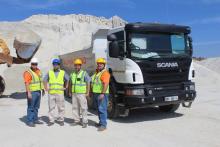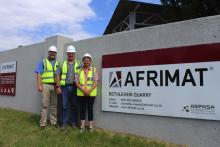After acquiring a previously loss-making opencast limestone mine, the new owner has implemented several changes to turn around the operation. One key modification, among many critical transformations, is the optimisation of drilling and blasting parameters which have, to a large extent, improved the utilisation of equipment, productivity and economics. By Munesu Shoko.
In March 2013, in line with its diversification strategy, Afrimat, one of South Africa’s leading open pit mining companies providing industrial minerals and construction materials, concluded a deal to take control of Infrasors, a producer of minerals for the mining, industrial, metallurgical and construction sectors. The deal saw Afrimat taking over the Lyttelton Centurion mine, an opencast dolomite mine in Pretoria, the Marble Hall mine, opencast limestone mining and beneficiation operation in Limpopo, and the Delf alluvial sand and silica operations at Donkerhoek, near Cullinan.
At the time, Infrasors reported lower earnings as sales of metallurgical minerals were knocked by strike action in the steel industry along with the shutdown of furnaces. “It’s always the best time to acquire a business at the bottom of the business cycle,” said Andries van Heerden, CEO of Afrimat.
After acquiring the three mines, Afrimat has since implemented its management practices and business processes throughout the operations. Two years down the line, Marble Hall Mine has invested a total of R11 million (about US$1 million) into turning around the previously loss-making operation, according to Stephan Becker, Marble Hall mine’s manager. The capital investment enabled new developments including the installation of a new intermediate stockpile (ISP), new feeder system, new culverts, new escape tunnel, a new plant processing agricultural lime, and a secondary optical sorter, among other improvements.
Several adjustments to the operational processes at Marble Hall mine were also implemented to eliminate bottlenecks in the system. These include an increased height of the ISP conveyor, which increased a storage area for primary crushed material from 500tonnes to 3500tonnes; removal of a primary washing screen, which, according to Becker, didn’t make business sense because it was washing away product that could be sold as fines for agricultural lime; as well as changing the size of feed material into the powder plant from 60mm to 9.5mm, which ultimately saw higher production tonnages and lower maintenance costs.
Becker also had to reduce the wage bill of the operation, which, at the time of his arrival in October 2013, had a total workforce of 75 people, now down to 25. This was achieved by cutting down many unnecessary shifts and getting rid of a labour broker. According to Becker, generally, a single worker should produce 1000tonnes/month, but the operation was only achieving 100tonnes/month per person, a true reflection of the managerial inefficiencies at the time.
Elsewhere, the new mine management started looking at alternative markets to include other new products such as metallurgical sinter, which can also be split into two products to generate 4mm fertiliser filler and agricultural lime. Other products are water treatment lime, animal feed powder and construction aggregates. This increased the product range from the previous four to a new total output of 15 products.
However, one of the major changes that has improved Marble Hall mine’s bottom line is the new drilling and blasting pattern.
Efficiency of drilling and blasting patterns in open pit mining determines, to a large extent, utilisation of equipment, productivity and economics, says Becker. Drilling and blasting, previously carried out once a month, is now done twice a month since the start of 2015. Previously outsourced to a contractor, this function is now carried out by Afrimat’s newly established Contracting division.
Drilling and blasting is now done to a gauged bench level. Every parameter including drill hole diameter, drill hole depth, average charge per hole and rock density is measured to get the desired blast outcome. The new team has since decreased the burden and spacing to 2 x 2.5m, while drilling with an 89mm diameter drill bit has increased the powder factor, which in turn, increases fragmentation of the material. Becker says proper fragmentation of blasted rock improves the efficiency of downstream operations including loading, hauling and crushing and screening.
An optimal blast not only results in proper fragmentation, but also reduces undesirable effects such as ground vibration, fly rock and formation of toe in mine benches. Drilling and blasting is also the first unit operation in the mining processes and has a crucial impact on the performance and cost of subsequent unit operations. According to Becker, an increase in the degree of fragmentation also gives loading equipment a higher rate of productivity. This translates into lower costs per tonne moved. The effect of wear and tear has also decreased, offering lower operating cost per hour.
“Each hole gets surveyed to get the resultant blast levelling right for better haul road condition, translating into fuel economy and less maintenance,” says Becker. Improved haul road condition also means increased truck production per hour, while a greater degree of fragmentation assures faster excavator loading rates in the pit and decreasing the rate of bridging at the crushers. This has consequently decreased cycle times.
Generally, the new drilling and blasting methods applied constitute a well-selected pattern that produces fragmentation that is easily being accommodated by the available loading and hauling equipment, as well as the crushing plant with no need for secondary blasting. “Performance of basic mining functions such as excavation and crushing relies on a fragmentation which has been preconditioned (sufficiently loose with adequate muck pole profile) by a blast.
Marble Hall mine is mining one pit at present, the Northern Pit, and when Aggregates Business International visited the site, Anton Penkler, business development manager at Afrimat, was driving a feasibility study to investigate the probability of mining the Southern Pit, where better material has been discovered. This is a long-term project, says Penkler. Meanwhile, the Nothern Pit has a 30-year life of mining based on the current pit design. There are sufficient minerals under the ground to satisfy the anticipated demand for metallurgical limestone and construction aggregate in different sizes. The pit has been mined to a depth of 32m and will reach a total depth of 80m when mined out. It has a total area of 350m x 300m, which can be increased by a further 300m on all sides.
Load and haul functions have been outsourced to a contractor, McKenzie Plant Hire, and Becker says it is the cost-effective solution at this stage. McKenzie was appointed when Afrimat took over the operation as the previous contractor couldn’t meet the expected production standards. A total of four
A 35tonne
Crushing and screening of construction aggregate has been outsourced to a contractor, Rockblend, due to the full utilisation of the fixed plant for metallurgical products. It has deployed a
A Bell L1806E loader is working at the stockpiles, loading customers’ trucks. It is using about 16 litres of diesel/hour. Meanwhile, a 966H Cat loader is used for general dispatching duties on site, consuming 18 to 22litres of diesel/hour. A Komatsu HM300 dumper working on the stockpiles complements the hauling line-up, while an



